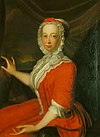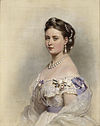Princess Royal
| Princess Royal | |
|---|---|
 | |
| Style | Her Royal Highness Ma'am |
| Residence | St James's Palace |
| Appointer | Monarch of the United Kingdom |
| Term length | Life tenure |
| Inaugural holder | Mary, Princess Royal and Princess of Orange |
Princess Royal is a style customarily (but not automatically) awarded by a British monarch to their eldest daughter. Although purely honorary, it is the highest honour that may be given to a female member of the Royal Family.[1] There have been seven Princesses Royal. Princess Anne is the current Princess Royal.[2]
The style Princess Royal came into existence when Queen Henrietta Maria (1609–1669), daughter of Henry IV, King of France, and wife of King Charles I (1600–1649), wanted to imitate the way the eldest daughter of the King of France was styled "Madame Royale".[3] Thus Princess Mary (born 1631), the daughter of Henrietta Maria and Charles, became the first Princess Royal in 1642.
It has become established that the style belongs to no one by right, but is given entirely at the Sovereign's discretion. Princess Mary (later Queen Mary II) (1662–1694), eldest daughter of King James II and VII, and Princess Sophia Dorothea (1687–1757), only daughter of King George I, were eligible for this honour but did not receive it. At the time they respectively became eligible for the style, Princess Mary was already Princess of Orange, while Sophia Dorothea was already Queen in Prussia.[1]
Princess Louisa Maria (1692–1712), the youngest daughter of King James II (died 1701), born after he lost his crown in the Glorious Revolution of 1688–1689, was considered to be Princess Royal during James's exile by Jacobites at Saint-Germain-en-Laye and was so called by them, even though she was not James's eldest living daughter at any time during her life.[3]
The title is held for life, even if the holder outlives her parent the monarch. On the death of a Princess Royal the style is not inherited by any of her daughters; instead, if the late Princess Royal's parent the monarch has also died, the new monarch may bestow it upon his or her own eldest daughter. Thus, Princess Louise was granted the style of Princess Royal by her father, King Edward VII in 1905; she retained it until her death in 1931, over twenty years into the reign of her brother King George V. Only upon Louise's death did the title become available for George's own daughter, Princess Mary, who was granted the title in 1932, retaining it until her death in 1965. Because Mary outlived not only her father but also her brother King George VI, the title was never available in George VI's reign to be granted his eldest daughter Princess Elizabeth (the present Queen Elizabeth II), though she would have been eligible to hold it.[1] Following Princess Anne's death, the next potentially eligible royal princess would be Princess Charlotte of Cambridge who could receive the title when her father, Prince William, Duke of Cambridge, becomes king. As of 2021, he is second in line to the throne.
Customarily, when a princess marries, she still takes on her husband's title. If her husband has a lower title or style, her style as a princess remains in use, although it may then be combined with her style by marriage, e.g. HRH The Princess Louise, Duchess of Argyll or HRH Princess Alice, Countess of Athlone – if that princess had a territorial designation, she may cease its use. Exceptionally, however, a princess who has been granted the title of HRH The Princess Royal will not customarily combine it with her style by marriage. For example, Princess Anne has been Her Royal Highness The Princess Royal since being given the title in 1987; prior to that, her formal title was Her Royal Highness The Princess Anne, Mrs Mark Phillips.[4]
List of title holders[]
The following is a complete list of women formally styled Princess Royal:
| Order | Princess Royal from (date) to (date) |
Portrait | Born | Marriages | Died |
|---|---|---|---|---|---|
| 1 | Princess Mary 1631–1660 also: Princess of Orange and Countess of Nassau (1641) |
 |
4 November 1631 St. James's Palace, London — ♦ — daughter of King Charles I and Queen Henrietta Maria |
William II, Prince of Orange 2 May 1641 1 son |
24 December 1660 Whitehall Palace, London |
| – | Princess Louisa Maria 1692–1712 (in exile) |
 |
28 June 1692 Château de Saint-Germain-en-Laye, France — ♦ — daughter of King James II and VII and Queen Mary |
— | 18 April 1712 Château de Saint-Germain-en-Laye, France |
| 2 | Princess Anne 1727–1759 also: Princess of Orange (1734) |
 |
2 November 1709 Herrenhausen Palace, Hanover — ♦ — daughter of King George II and Queen Caroline |
William IV of Orange 25 March 1734 3 children |
12 January 1759 The Hague, Netherlands |
| 3 | Princess Charlotte 1789–1828 also: Queen consort of Württemberg (1806) |
 |
29 September 1766 Buckingham House, London — ♦ — daughter of King George III and Queen Charlotte |
Frederick I of Württemberg 18 May 1797 1 daughter |
5 October 1828 Ludwigsburg Palace, Baden-Württemberg |
| 4 | Princess Victoria 1841–1901 also: German Empress and Queen consort of Prussia (1888) |
 |
21 November 1840 Buckingham Palace, London — ♦ — daughter of Queen Victoria and Prince Albert |
Frederick III, German Emperor 25 January 1858 8 children |
5 August 1901 Schloss Friedrichshof, Hesse |
| 5 | Princess Louise 1905–1931 also: Duchess of Fife (1889) |
 |
20 February 1867 Marlborough House, London — ♦ — daughter of King Edward VII and Queen Alexandra |
Alexander Duff, 1st Duke of Fife 27 July 1889 3 children |
4 January 1931 Portman Square, London |
| 6 | Princess Mary 1932–1965 also: Countess of Harewood (1929) |
 |
25 April 1897 York Cottage, Sandringham — ♦ — daughter of King George V and Queen Mary |
Henry Lascelles, 6th Earl of Harewood 28 February 1922 2 sons |
28 March 1965 Harewood House, West Yorkshire |
| 7 | Princess Anne 1987–present |
 |
15 August 1950 Clarence House, London — ♦ — daughter of Queen Elizabeth II and Prince Philip |
Mark Phillips 14 November 1973 2 children |
— now 71 years, 156 days old |
| Sir Timothy Laurence 12 December 1992 |
In fiction[]
- In the House of M alternate universe of Marvel Comics, Elizabeth Braddock is the elder twin sister of the British King and bears the title Princess Royal.
- The novel The Lady Royal, by Molly Costain Haycraft, is a fictionalized account of the life of Isabella de Coucy. According to the narrative, Isabella was titled the Princess Royal and then later given the more 'adult' title of the Lady Royal by her parents. This is a fabrication; although Isabella, as the eldest daughter of Edward III, enjoyed the special privileges that came with her rank, she could not have been titled the Princess Royal because the title was not used in England until long after her death. The title of "the Lady Royal" has never existed.
Other uses[]
Princess Royal was one of the GWR 3031 Class locomotives that were built for and run on the British Great Western Railway between 1891 and 1915. The LMS Class 8P "Princess Royal" 4-6-2 was a type of express passenger locomotive built between 1933 and 1935 by the London, Midland and Scottish Railway.
Princess Royal is an abandoned town in the Western Australian Goldfields, named for Victoria, Princess Royal, daughter of Queen Victoria.
Five ships of the Royal Navy have been named HMS Princess Royal.
"The Princess Royal" is also the name of a folk tune from the British Isles, and of a morris dance performed to that tune.[5]
In the Thai monarchy, the style of Sayamboromrajakumari (Thai: สยามบรมราชกุมารี; RTGS: Sayam boromma ratcha kumari) for Princess Sirindhorn of Thailand is similar to the position of Princess Royal.[6]
In the Kingdom of Tonga, Princess Sālote Mafileʻo Pilolevu is also the Princess Royal.
In a number of African monarchies, the title of the principal non-spousal female titleholder in the kingdom is often translated as Princess Royal. This usually happens in kingdoms that do not make use of the higher title of queen mother. Princess Elizabeth, Batebe of Toro in Uganda, for example, often has her title translated in this manner. This happens even though it has historically meant something closer to "queen sister".
References[]
- ^ a b c "Royal Titles: Style and Title of the Princess Royal". The British Monarchy. n.d. Archived from the original on July 27, 2008. Retrieved 8 July 2014.CS1 maint: unfit URL (link)
- ^ "The Princess Royal". The British Monarchy. n.d. Retrieved 8 July 2014.
- ^ a b Panton, Kenneth J. (2011). Historical Dictionary of the British Monarchy. Lanham, Maryland, US: Scarecrow Press, Inc. pp. 381–2. Retrieved 8 July 2014.
- ^ Davies, Nicholas (2013). Elizabeth II: Behind Palace Doors. Random House. ISBN 9781780578279.
Until Elizabeth gave her the title, Anne's correct form of address had been a mouthful, 'Her Royal Highness the Princess Anne, Mrs Mark Phillips'.
- ^ "Princess Royal". folkopedia.info. English Folk Dance and Song Society. 2 July 2007.
- ^ McCargo, Duncan (2010), "Thailand", Regional Oulook: Southeast Asia 2010-2011 (Institute of Southeast Asian Studies): 55
- Royal titles
- Princesses Royal
- Lists of princesses
